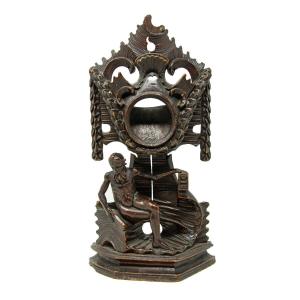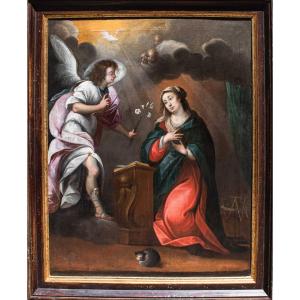Mathieu van Plattenberg, detto Monsù Montagna (Anversa, 1608-Parigi, 1660)
Burrasca con velieri
Olio su tela, cm 62,5 x 98
Con cornice, cm 87,5 x 122 x 8
Affasciante marina che va ad arricchire il catalogo di Matthieu Plattenberg, meglio noto come Monsù Montagna. Roboanti nuvole incombono sulle onde dal guizzo graffiante, in un turbinio pittorico di vento e salati scrosci di spuma marina. Con straordinaria destrezza formale l’artista materializza il buio smeraldo delle profondità marine, pronte ad inghiottire la manciata di velieri sferzati dal vento; massimo verismo viene raggiunto nel dettaglio dell’acqua che si frantuma in nebulose goccioline sugli scogli, sulla destra del dipinto. La commistione figurale di questi elementi appartenne all’intera produzione del Plattenberg, menzionato già nella Felsina pittrice del Malvasia (1678), quindi nella Storia pittorica dell’Italia dell’abate Luigi Lanzi (1792-1809). È a questo trattato che occorre ricondurre una nodale confusione identitaria, eccellentemente sciolta dalla monografia di Roethlisberger (Bianco, Cavalier Tempesta and his Time - University Delaware Press, Delaware, 1970). Il Lanzi suppose corretto identificare nel “Montagna”, citato da diverse fonti prima di lui, un olandese pittor di mare che finì per essere nominato, successivamente, come Renaud de la Montagne. La pubblicazione del Roethlisberger dimostrò che nel Montagna fosse invece da riconoscersi l’artista fiammingo Matthieu Plattenberg, nato ad Anversa nel 1608. L’artista prese il soprannome da Andries van Eertvelt, incisore e disegnatore di ricami presso cui svolse l’apprendistato giovanile; soggiornò nella penisola italiana attorno ai vent’anni, al seguito del maestro, raggiungendo la città di Firenze. Qui Plattenberg non fu collaboratore di Jan Asselijn, come spesso scritto: negli anni fiorentini di Asselijn, tra il 1635 e il 1644, il Montagna si trovava a Parigi, raggiunta attorno al 1630. L’artista si dedicò alla prolifica realizzazione di mar
3469 / 2000
àéèìîóòù
Mathieu van Plattenberg, known as Monsù Montagna (Antwerp, 1608-Paris, 1660)
Storm with sailboats
Oil on canvas, cm 62,5 x 98
With frame, cm 87,5 x 122 x 8
Affasciante marina that goes to enrich the catalog of Matthieu Plattenberg, better known as Monsù Montagna. Roaring clouds loom over the waves with a scratching flicker, in a picturesque whirlwind of wind and salty splashes of sea foam. With extraordinary formal dexterity the artist materializes the dark emerald of the deep sea, ready to swallow the handful of sails whipped by the wind; maximum verismo is achieved in the detail of the water that breaks into nebulous droplets on the rocks, on the right of the painting. The figurative mixture of these elements belonged to the entire production of Plattenberg, already mentioned in the Felsina pittrice del Malvasia (1678), then in the pictorial history of Italy by Abbot Luigi Lanzi (1792-1809). It is to this treatise that a nodal confusion of identity must be traced, excellently dissolved by the monograph of Roethlisberger (Bianco, Cavalier Tempesta and his Time - University Delaware Press, Delaware, 1970). Lanzi assumed correct identification in the "Mountain", mentioned by several sources before him, a Dutch sea painter who ended up being named later as Renaud de la Montagne. The publication of Roethlisberger showed that in the Mountain was to be recognized instead the Flemish artist Matthieu Plattenberg, born in Antwerp in 1608. The artist took his nickname from Andries van Eertvelt, engraver and embroidery designer at whom he was apprenticed as a young man; he stayed in the Italian peninsula around twenty years, following the master, reaching the city of Florence. Here Plattenberg was not a collaborator of Jan Asselijn, as often written: in the Florentine years of Asselijn, between 1635 and 1644, the Montagne was located in Paris, reached around 1630.The artist devoted himself to the prolific realization of stormy seas, sometimes signed Mountains, Montaigne or Platte-Montagne; participant in the foundation of the Académie Royale de Peinture et de Sculpture in Paris in 1648, loved to define himself for the entirety of his life, rightly, "Peintre du Roy pours les mers". Later only Pieter Mulier, nicknamed the Storm Rider, was his equal; although more classically, Mulier was sometimes attributed with paintings from the Plattenberg, even since the time of Lanzi. A similar fate befell the son of the Mountain, known to sources as Nicolas de Plattemontagne, active in Paris and the decoration of the Tuileries; even Nicolas’s works were for a long time wrongly attributed to his master, Philippe de Champaigne. Remember how even Evaristo Baschenis, a well-known painter and priest from Bergamo, possessed works of the Montagna: fervent collector of contemporary works, Baschenis joined to this Flemish some pearls of the Roman Ciro Ferri, of the Trentino Andrea Pozzo and of the cremasco Gian Giacomo Barbelli, his ancient master, as can be seen from a note in the testamentary.
The obvious authorship of the painting is evident in comparison with other scenes of storm performed by the artist: remember, in addition to the examples located in private collections, the similar canvases now kept at the Chamber of Deputies of Palazzo Montecitorio, the Royal Museums of Greenwich and the Tosio Martinengo Art Gallery of the Civic Museums of Art and History of Brescia.
















































 Le Magazine de PROANTIC
Le Magazine de PROANTIC TRÉSORS Magazine
TRÉSORS Magazine Rivista Artiquariato
Rivista Artiquariato